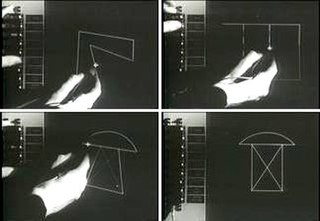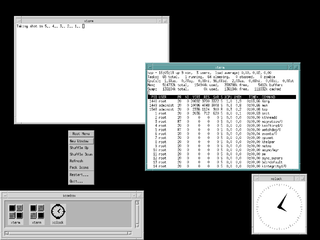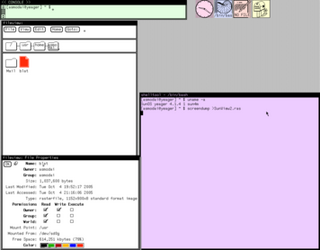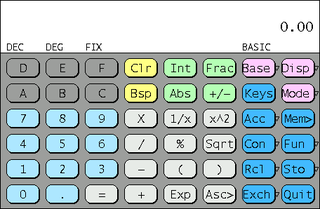
The Common Desktop Environment (CDE) is a desktop environment for Unix and OpenVMS, based on the Motif widget toolkit. It was part of the UNIX 98 Workstation Product Standard, and was for a long time the Unix desktop associated with commercial Unix workstations. It helped to influence early implementations of successor projects such as KDE and GNOME desktop environment, which largely replaced CDE following the turn of the century.
The GUI, graphical user interface, is a form of user interface that allows users to interact with electronic devices through graphical icons and audio indicator such as primary notation, instead of text-based UIs, typed command labels or text navigation. GUIs were introduced in reaction to the perceived steep learning curve of CLIs, which require commands to be typed on a computer keyboard.

The history of the graphical user interface, understood as the use of graphic icons and a pointing device to control a computer, covers a five-decade span of incremental refinements, built on some constant core principles. Several vendors have created their own windowing systems based on independent code, but with basic elements in common that define the WIMP "window, icon, menu and pointing device" paradigm.

The X Window System is a windowing system for bitmap displays, common on Unix-like operating systems.

Solaris is a proprietary Unix operating system originally developed by Sun Microsystems. After the Sun acquisition by Oracle in 2010, it was renamed Oracle Solaris.
OpenStep is a defunct object-oriented application programming interface (API) specification for a legacy object-oriented operating system, with the basic goal of offering a NeXTSTEP-like environment on non-NeXTSTEP operating systems. OpenStep was principally developed by NeXT with Sun Microsystems, to allow advanced application development on Sun's operating systems, specifically Solaris. NeXT produced a version of OpenStep for its own Mach-based Unix, stylized as OPENSTEP, as well as a version for Windows NT. The software libraries that shipped with OPENSTEP are a superset of the original OpenStep specification, including many features from the original NeXTSTEP.

NeWS is a discontinued windowing system developed by Sun Microsystems in the mid-1980s. Originally known as "SunDew", its primary authors were James Gosling and David S. H. Rosenthal. The NeWS interpreter was based on PostScript extending it to allow interaction and multiple "contexts" to support windows. Like PostScript, NeWS could be used as a complete programming language, but unlike PostScript, NeWS could be used to make complete interactive programs with mouse support and a GUI.
In computing, a desktop environment (DE) is an implementation of the desktop metaphor made of a bundle of programs running on top of a computer operating system that share a common graphical user interface (GUI), sometimes described as a graphical shell. The desktop environment was seen mostly on personal computers until the rise of mobile computing. Desktop GUIs help the user to easily access and edit files, while they usually do not provide access to all of the features found in the underlying operating system. Instead, the traditional command-line interface (CLI) is still used when full control over the operating system is required.

In computing, Motif refers to both a graphical user interface (GUI) specification and the widget toolkit for building applications that follow that specification under the X Window System on Unix and Unix-like operating systems. The Motif look and feel is distinguished by its use of rudimentary square and chiseled three-dimensional effects for its various user interface elements.
MoOLIT is a graphical user interface library and application programming interface (API) created by Unix System Laboratories in an attempt to create a bridge between the two competing look-and-feels for Unix workstations at the time: OPEN LOOK and OSF Motif.
Common User Access (CUA) is a standard for user interfaces to operating systems and computer programs. It was developed by IBM and first published in 1987 as part of their Systems Application Architecture. Used originally in the MVS/ESA, VM/CMS, OS/400, OS/2 and Microsoft Windows operating systems, parts of the CUA standard are now implemented in programs for other operating systems, including variants of Unix. It is also used by Java AWT and Swing.
In computing, the X Window System is a network-transparent windowing system for bitmap displays. This article details the protocols and technical structure of X11.

SunView is a discontinued windowing system from Sun Microsystems developed in the early 1980s. It was included as part of SunOS, Sun's UNIX implementation; unlike later UNIX windowing systems, much of it was implemented in the system kernel. SunView ran on Sun's desktop and deskside workstations, providing an interactive graphical environment for technical computing, document publishing, medical, and other applications of the 1980s, on high resolution monochrome, greyscale and color displays.

XView is a widget toolkit from Sun Microsystems introduced in 1988. It provides an OPEN LOOK user interface for X Window System applications, with an object-oriented application programming interface (API) for the C programming language. Its interface, controls, and layouts are very close to that of the earlier SunView window system, making it easy to convert existing applications from SunView to X. Sun also produced the User Interface Toolkit (UIT), a C++ API to XView.

OpenWindows is a discontinued desktop environment for Sun Microsystems workstations which combined SunView, NeWS, and X Window System protocols. OpenWindows was included in later releases of the SunOS 4 and Solaris operating systems, until its removal in Solaris 9 in favor of Common Desktop Environment (CDE) and GNOME 2.0.
A PIGUI package is a software library that a programmer uses to produce GUI code for multiple computer platforms. The package presents subroutines and/or objects which are independent of the GUIs that the programmer is targeting. For software to qualify as PIGUI it must support several GUIs under at least two different operating systems. The package does not necessarily provide any additional portability features. Native look and feel is a desirable feature, but is not essential for PIGUIs.

The Common Open Software Environment (COSE) was an initiative formed in March 1993 by the major Unix vendors of the time to create open, unified operating system (OS) standards.
OLIT is a widget toolkit from Sun Microsystems introduced in 1988, providing an OPEN LOOK user interface for X Window System applications. It provides an Xt application programming interface for the C programming language, providing an easy way for those familiar with Xt programming to implement the OPEN LOOK look and feel.

The Abstract Window Toolkit (AWT) is Java's original platform-dependent windowing, graphics, and user-interface widget toolkit, preceding Swing. The AWT is part of the Java Foundation Classes (JFC) — the standard API for providing a graphical user interface (GUI) for a Java program. AWT is also the GUI toolkit for a number of Java ME profiles. For example, Connected Device Configuration profiles require Java runtimes on mobile telephones to support the Abstract Window Toolkit.















